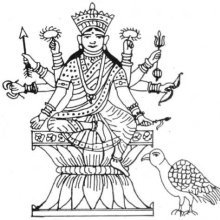Cakreshvari, Cakreśvarī, Cakreśvari, Cakra-ishvari: 10 definitions
Introduction:
Cakreshvari means something in Hinduism, Sanskrit, Jainism, Prakrit. If you want to know the exact meaning, history, etymology or English translation of this term then check out the descriptions on this page. Add your comment or reference to a book if you want to contribute to this summary article.
The Sanskrit terms Cakreśvarī and Cakreśvari can be transliterated into English as Cakresvari or Cakreshvari, using the IAST transliteration scheme (?).
Alternative spellings of this word include Chakreshvari.
Images (photo gallery)
In Hinduism
Purana and Itihasa (epic history)
Source: archive.org: Nilamata Purana: a cultural and literary studyCakreśvarī (चक्रेश्वरी) is the name of a Goddess that was once worshipped in ancient Kashmir (Kaśmīra) as mentioned in the Nīlamatapurāṇa.—These Goddesses (e.g., Cakreśvarī) form the shining galaxy of female deities worshipped by the people of Kaśmīra.
Source: Cologne Digital Sanskrit Dictionaries: The Purana IndexCakreśvari (चक्रेश्वरि).—A name of Lalitā.*
- * Brahmāṇḍa-purāṇa IV. 17. 19; 18. 15.

The Purana (पुराण, purāṇas) refers to Sanskrit literature preserving ancient India’s vast cultural history, including historical legends, religious ceremonies, various arts and sciences. The eighteen mahapuranas total over 400,000 shlokas (metrical couplets) and date to at least several centuries BCE.
Shaktism (Shakta philosophy)
Source: Google Books: ManthanabhairavatantramCakreśvarī (चक्रेश्वरी) refers to the “mistress of the wheel”, according to the Manthānabhairavatantra, a vast sprawling work that belongs to a corpus of Tantric texts concerned with the worship of the goddess Kubjikā.—Accordingly, “(She is) the Vidyā who bears Bhairava’s form. The energy of Kālī in the Age of Strife, she is Kaulinī come forth from the divine in Hara’s teaching. On the Krama path she should be praised as Umā and Carcikā. She is Khecarī marked with Śrīnātha, to whom the gods bow. She is the mistress of the wheel (cakreśvarī), Vakrikā within the couple (of Śiva and Śakti) and the supreme energy”.

Shakta (शाक्त, śākta) or Shaktism (śāktism) represents a tradition of Hinduism where the Goddess (Devi) is revered and worshipped. Shakta literature includes a range of scriptures, including various Agamas and Tantras, although its roots may be traced back to the Vedas.
In Jainism
General definition (in Jainism)
Source: archive.org: The Jaina IconographyCakreśvarī (चक्रेश्वरी) (lit., “Goddess of wheels”) or Apaticakrā is the name of the Yakṣiṇī accompanying Ṛṣabhanātha: the first of twenty-four Tīrthaṃkaras or Jinas, commonly depicted in Jaina iconography.—The tree connected with the first Jina is Nyagrodha or the Indian Banyan tree. Other iconographic marks of the Jina are his Yakṣa named Gomukha (lit., Bull-Faced) and Yakṣiṇī Cakreśvarī (Goddess of wheels) or Apaticakrā. The texts give two worshippers on either side of Ṛṣabhadeva viz., Bharata and Bāhubali.
The Śvetāmbaras and the Digambaras concurrently describe Cakreśvarī as holding the symliol of disc and riding a Garuḍa. The Śvetāmbara image has eight hands, which carry Varada-mudrā arrow, disc, noose, bow, thunder, disc, goad. The Digambara image, on the other hand, is represented as having either twelve or four hands. In case of twelve, the attributes are these:—eight discs, citrus, Varada-mudrā, and two Vajras. The four-handed figure holds two discs.
Source: HereNow4U: Svasti - EssaysCakreśvarī (चक्रेश्वरी), the goddess who attends upon Ādinātha, is not important either at the Kattale Basati (“dark temple”) or elsewhere at Sravana Belgola. She is much more important in north Indian Śvetāmbara Jain ritual culture.

Jainism is an Indian religion of Dharma whose doctrine revolves around harmlessness (ahimsa) towards every living being. The two major branches (Digambara and Svetambara) of Jainism stimulate self-control (or, shramana, ‘self-reliance’) and spiritual development through a path of peace for the soul to progess to the ultimate goal.
Languages of India and abroad
Sanskrit dictionary
Source: DDSA: The practical Sanskrit-English dictionaryCakreśvarī (चक्रेश्वरी).—Name of the Jaina goddess of learning.
Cakreśvarī is a Sanskrit compound consisting of the terms cakra and īśvarī (ईश्वरी).
Source: Cologne Digital Sanskrit Dictionaries: Shabda-Sagara Sanskrit-English DictionaryCakreśvarī (चक्रेश्वरी).—f. (-rī) A female deity peculiar to the Jainas, one of their Vidya Devis or goddesses of wisdom. E. cakra the universe and īśvarī mistress.
Source: Cologne Digital Sanskrit Dictionaries: Monier-Williams Sanskrit-English DictionaryCakreśvarī (चक्रेश्वरी):—[from cakreśvara > cakra] f. one of the Vidyā-devīs (executing the orders of the 1st Arhat), [cf. Lexicographers, esp. such as amarasiṃha, halāyudha, hemacandra, etc.]
Source: Cologne Digital Sanskrit Dictionaries: Yates Sanskrit-English DictionaryCakreśvarī (चक्रेश्वरी):—[cakre-śvarī] (rī) 3. f. A female deity peculiar to the Jainas.
Source: DDSA: Paia-sadda-mahannavo; a comprehensive Prakrit Hindi dictionary (S)Cakreśvarī (चक्रेश्वरी) in the Sanskrit language is related to the Prakrit word: Cakkesarī.
Sanskrit, also spelled संस्कृतम् (saṃskṛtam), is an ancient language of India commonly seen as the grandmother of the Indo-European language family (even English!). Closely allied with Prakrit and Pali, Sanskrit is more exhaustive in both grammar and terms and has the most extensive collection of literature in the world, greatly surpassing its sister-languages Greek and Latin.
See also (Relevant definitions)
Partial matches: Ishvari, Svari, Cakra.
Full-text: Cakkesari, Kuladeva, Nyagrodha, Shasana, Rishabhanatha, Ardhaparyanka, Ardhaparyankasana, Kramapatha, Harashasana, Rishabha, Diksa, Ayodhya, Gomukha.
Relevant text
Search found 5 books and stories containing Cakreshvari, Cakreśvarī, Cakreśvari, Cakra-ishvari, Cakresvari, Cakra-īśvarī, Cakra-isvari, Cakre-shvari, Cakre-śvarī, Cakre-svari; (plurals include: Cakreshvaris, Cakreśvarīs, Cakreśvaris, ishvaris, Cakresvaris, īśvarīs, isvaris, shvaris, śvarīs, svaris). You can also click to the full overview containing English textual excerpts. Below are direct links for the most relevant articles:
Jain Remains of Ancient Bengal (by Shubha Majumder)
Single depiction of Ṛṣabhanātha sculptures < [Chapter 6 - Iconographic Study of Jaina Sculptural Remains]
Ṛṣabhanātha sculptures with miniature Tīrthaṅkaras and Dikpālas < [Chapter 6 - Iconographic Study of Jaina Sculptural Remains]
Lalitopakhyana (Lalita Mahatmya) (by G.V. Tagare)
Chapter 18 - The victorious march of the army of Lalitā Parameśvarī
Chapter 44 - Meditation on the Goddess
The Nilamata Purana (by Dr. Ved Kumari)
A study of the philosophy of Jainism (by Deepa Baruah)
Chapter I.c - The lives of the Tīrthaṅkaras < [Chapter I - Introduction]
Shakti and Shakta (by John Woodroffe)
Chapter VI - Śakti and Śākta < [Section 1 - Introductory]
